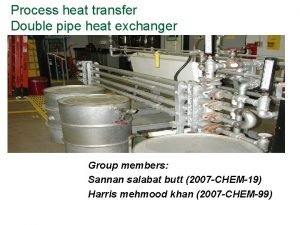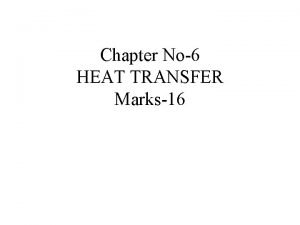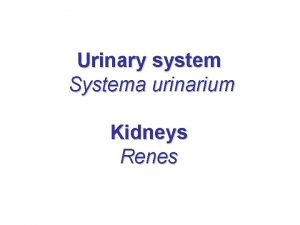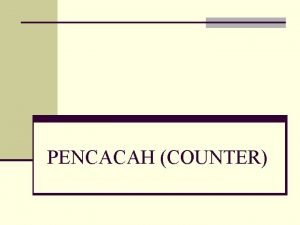Effects of Cocurrent and Counter Current Flow on


- Slides: 2

Effects of Co-current and Counter Current Flow on Heat Exchange in Packed Bed Reactors Garrett St. Laurent, Janice Mugisha, Thomas Carter Department of Chemical Engineering, University of New Hampshire RESULTS INTRODUCTION • • They are primarily used when heating or cooling a system This experiment focused primarily on that of heat transfer to an air stream from a water jacket. Catalyst or Carbon Particles are the most commonly used beds Effects of Counter and Cocurrent Flow on Heat Transfer Coefficient 14 16 14 12 Overall Heat Transfer Coefficient U [W/(K*m^2)] • Packed Bed Reactors are extremely useful in many chemical processes such as separation processes, stripping, distillation and catalytic reactors. Overall Heat Transfer Coefficient U [W/(K*m^2)] • DESIGN PROBLEM CONT. 10 8 6 4 2 • Heat transfer within the reactor is affected by flow rate and area 0 12 10 8 6 4 2 0. 0068/10 0. 0068/20 0. 0068/30 0. 0068/40 0 0. 0068/50 10 20 Flow Rate of Air [SCFH] @ 30 Figure 1: Overall Heat Transfer Coefficient versus Flow Rate of Air for Counter and Cocurrent Flows (Light Blue Cocurrent/Orange Countercurrent) 30 40 50 Flow Rate of Air [SCFH] @ 70 Figure 2: Overall Heat Transfer Coefficient versus Flow Rate of Air for Counter and Cocurrent Flows (Green Cocurrent/Dark Blue Countercurrent) Effects of Water Flow rate on Overall Heat Transfer Coefficient 14 • • • Main Objectives: Find Overall Heat Transfer Coefficient, determine the effects of water and air flow rates, and use the results to find a solution to the design problem The experiment was conducted in a down-scaled pre-designed packed bed Overall Heat Transfer Coefficient U [W/[K*m^2)] 12 10 8 6 4 10 The overall heat transfer coefficient increases as air flow rates increases, 8 6 though there seems to be minimal effect on the heat transfer coefficient 4 based on the water flow rate. This effect appears to increase, however as 2 2 0 12 0 0. 0068/10 0. 0068/20 0. 0068/30 0. 0068/40 Flow Rate of Water/Air [(L/s)/SCFH] 0. 0068/50 Figure 3: Overall Heat Transfer Coefficient versus Flow Rate of Air at different Water Flow Rates (Dark blue; 0. 015, Orange; 0. 0068 water flow rate. 0. 015/10 0. 015/20 0. 015/30 0. 015/40 0. 015/50 Flow Rate of Water/Air [(L/s)/SCFH] Figure 4: Overall Heat Transfer Coefficient versus Flow Rate of Air at different Water Flow Rates (Green; 0. 015, Light Blue; 0. 0068 water flow rate. the air flow rates increase. This correlation also appears to affect the cocurrent versus counter current difference, though much less than it does for the water flow effect. Counter current flow appears to generally have a higher heat transfer coefficients than co-current. As one might expect, the Thermal couples were strategically positioned around the reactor to record temperature changes at inlets and outlets for five different air flow rates and 2 different water flow rates. higher water flow rate does also have the higher heat transfer coefficient. Using this information, an answer to the design problem was found. DESIGN PROBLEM The flow diagram shown below is for co-current flow. For counter current flow, the water streams would be flipped, but the air streams were kept as in at the bottom and out at the top. • • If a gas leaves a reactor at 75°C is to be cooled with a water-cooled jacket. The flow rate of the gas is 100 SCFM and it leaves the bed at 30°C. Specify the length and diameter of the packed column, assuming the gas has the properties of air. Assuming a water flow rate of 0. 016 L/s, as in the highest U calculated from the data. The value of U for the problem 16 • • U = 0. 2847(6000) – 0. 2054 U = 1707. 9946 Overall Heat Transfer Coefficient U [W/(K*m^2)] • Overall Heat Transfer Coefficient U [W/[K*m^2)] 14 METHODS CONCLUSIONS 16 16 • Foley, A. (2014, August 15). What Is a Packed Bed Reactor? Retrieved April 29, 2018, from https: //www. comsol. com/blogs/packed-bedreactor/ • Geankoplis, Christie J. Transport Processes and Separation Process Principles (Includes Unit Operations) Fourth Edition. Prentice Hall, 2003. • Pashian, Gary. Packed Bed Scrubbers Applications & Engineering https: //www. monroeenvironmental. com/ (accessed Apr 30, 2018). 14 12 10 8 6 4 2 0 SOURCES 0 10 20 30 40 50 Flow Rate of Air [SCFH] @ 70 60

This poster template provided courtesy of UNH ESRC Poster Printing Services Trust us to make your poster look GREAT! Website: http: //posters. unh. edu Poster Guide: http: //goo. gl/1 E 7 TJY DELETE THIS SLIDE BEFORE PRINTING



